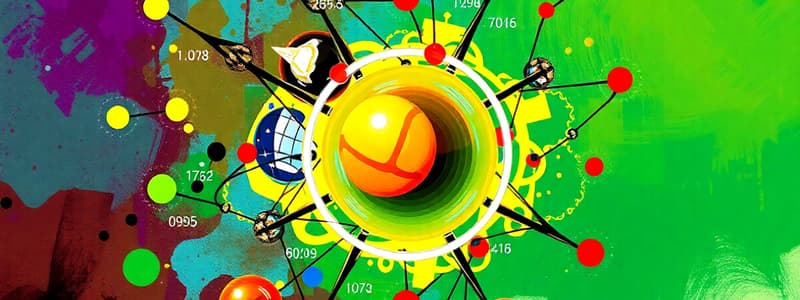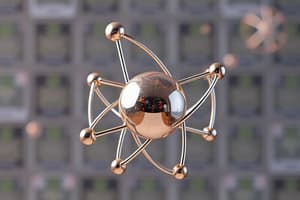Podcast
Questions and Answers
Explain how the arrangement of elements in the periodic table reflects their electron configurations and resulting chemical properties.
Explain how the arrangement of elements in the periodic table reflects their electron configurations and resulting chemical properties.
Elements in the same group (vertical column) have similar valence electron configurations, leading to similar chemical properties. Elements in the same period (horizontal row) have the same number of electron shells.
Compare and contrast ionic and covalent bonds in terms of electron behavior and the types of elements typically involved.?
Compare and contrast ionic and covalent bonds in terms of electron behavior and the types of elements typically involved.?
Ionic bonds involve the transfer of electrons between a metal and a nonmetal, resulting in charged ions that are attracted to each other. Covalent bonds involve the sharing of electrons between two nonmetals to achieve a stable electron configuration.
Explain how the principle of Le Chatelier's principle affects the equilibrium of a chemical reaction when concentration or temperature is changed.
Explain how the principle of Le Chatelier's principle affects the equilibrium of a chemical reaction when concentration or temperature is changed.
Le Chatelier's principle states that if a change of condition (like concentration or temperature) is applied to a system in equilibrium, the system will shift in a direction that relieves the stress. For concentration, adding more reactant will shift the equilibrium towards the products, and vice versa. For temperature, increasing the temperature will favor the endothermic reaction, while decreasing the temperature will favor the exothermic reaction.
Describe how electronegativity differences between atoms in a bond can predict the type of bond that will form (ionic, polar covalent, or nonpolar covalent).
Describe how electronegativity differences between atoms in a bond can predict the type of bond that will form (ionic, polar covalent, or nonpolar covalent).
Describe the relationship between enthalpy, entropy, and Gibbs free energy, and how they determine the spontaneity of a chemical reaction.
Describe the relationship between enthalpy, entropy, and Gibbs free energy, and how they determine the spontaneity of a chemical reaction.
Explain how a catalyst increases the rate of a chemical reaction, and provide an example of a catalytic process.
Explain how a catalyst increases the rate of a chemical reaction, and provide an example of a catalytic process.
Balance the following chemical equation: H2 + O2 -> H2O
Balance the following chemical equation: H2 + O2 -> H2O
Explain how the kinetic molecular theory accounts for the differences in properties between solids, liquids and gases.
Explain how the kinetic molecular theory accounts for the differences in properties between solids, liquids and gases.
A solution is prepared by dissolving 25 g of NaCl in 250 mL of water. Calculate the concentration of the solution in terms of mass percent and molarity. (Assume the density of water is 1 g/mL and the molar mass of NaCl is 58.44 g/mol.)
A solution is prepared by dissolving 25 g of NaCl in 250 mL of water. Calculate the concentration of the solution in terms of mass percent and molarity. (Assume the density of water is 1 g/mL and the molar mass of NaCl is 58.44 g/mol.)
Describe the key differences between a homogeneous mixture and a heterogeneous mixture, providing an example of each.
Describe the key differences between a homogeneous mixture and a heterogeneous mixture, providing an example of each.
Using stoichiometry, determine the mass of carbon dioxide produced when 100g of propane (C3H8) is combusted completely. Show balanced equation and all steps.
(Molar mass: C3H8 = 44.1 g/mol, CO2 = 44.0 g/mol)
Using stoichiometry, determine the mass of carbon dioxide produced when 100g of propane (C3H8) is combusted completely. Show balanced equation and all steps. (Molar mass: C3H8 = 44.1 g/mol, CO2 = 44.0 g/mol)
How does an atom's atomic number and mass number relate to the number of protons, neutrons, and electrons it contains?
How does an atom's atomic number and mass number relate to the number of protons, neutrons, and electrons it contains?
A chemist tests a solid material and finds that it is shiny, malleable, and conducts electricity. Based only on this information, is the material more likely to be a metal, nonmetal, or metalloid? What are the limitations of making a determination based only on these characteristics?
A chemist tests a solid material and finds that it is shiny, malleable, and conducts electricity. Based only on this information, is the material more likely to be a metal, nonmetal, or metalloid? What are the limitations of making a determination based only on these characteristics?
Flashcards
Solvent
Solvent
The substance that dissolves the solute in a solution.
pH Scale
pH Scale
Measures the acidity or basicity of a solution.
Stoichiometry
Stoichiometry
The study of quantitative relationships in chemical reactions.
Enthalpy (ΔH)
Enthalpy (ΔH)
Signup and view all the flashcards
Catalysts
Catalysts
Signup and view all the flashcards
Atom
Atom
Signup and view all the flashcards
Protons
Protons
Signup and view all the flashcards
Atomic Number
Atomic Number
Signup and view all the flashcards
Isotope
Isotope
Signup and view all the flashcards
Ionic Bond
Ionic Bond
Signup and view all the flashcards
Covalent Bond
Covalent Bond
Signup and view all the flashcards
Chemical Reaction
Chemical Reaction
Signup and view all the flashcards
States of Matter
States of Matter
Signup and view all the flashcards
Study Notes
Atomic Structure
- Atoms are the fundamental building blocks of matter.
- Atoms are composed of a nucleus containing protons and neutrons, surrounded by orbiting electrons.
- Protons have a positive charge, electrons have a negative charge, and neutrons have no charge.
- The number of protons in an atom's nucleus determines its atomic number and defines the element.
- The mass number of an atom is the sum of its protons and neutrons.
- Isotopes are atoms of the same element with different numbers of neutrons.
Periodic Table
- The periodic table arranges elements by increasing atomic number.
- Elements with similar properties are grouped together in columns called groups or families.
- Rows are called periods.
- Elements are categorized as metals, nonmetals, and metalloids based on their properties.
- Metals are generally good conductors of heat and electricity, malleable, and ductile.
- Nonmetals are generally poor conductors of heat and electricity, brittle, and often exist as gases or insulators.
- Metalloids exhibit properties of both metals and nonmetals.
Bonding
- Chemical bonds hold atoms together in molecules and compounds.
- Ionic bonds form between a metal and a nonmetal, involving the transfer of electrons from the metal to the nonmetal.
- Covalent bonds form between nonmetals, involving the sharing of electrons between atoms.
- Metallic bonds occur in metals, involving a "sea" of delocalized electrons.
- Electronegativity measures an atom's ability to attract electrons in a chemical bond.
Chemical Reactions
- Chemical reactions involve the rearrangement of atoms to form new substances.
- Reactants are the substances that undergo change.
- Products are the substances formed in the reaction.
- Chemical equations represent reactions using chemical formulas and coefficients.
- Balancing chemical equations ensures that the number of atoms of each element is the same on both sides of the equation.
- Reactions can be classified as synthesis, decomposition, single displacement, double displacement, or combustion.
States of Matter
- Matter exists in three primary states: solid, liquid, and gas.
- Solids have a fixed shape and volume due to strong forces of attraction between particles.
- Liquids have a fixed volume but take the shape of their container, with weaker forces of attraction between particles than solids.
- Gases have neither a fixed shape nor a fixed volume, with particles moving freely and weak forces of attraction.
Solutions
- Solutions are homogeneous mixtures of two or more substances.
- The solute is the substance that is dissolved.
- The solvent is the substance that dissolves the solute.
- Concentration measures the amount of solute dissolved in a given amount of solvent.
- Solutions can be saturated, unsaturated, or supersaturated depending on the amount of solute dissolved.
Acids and Bases
- Acids are substances that release hydrogen ions (H+) in water.
- Bases are substances that release hydroxide ions (OH-) in water.
- The pH scale measures the acidity or basicity of a solution.
- Acids have a pH less than 7, bases have a pH greater than 7, and neutral solutions have a pH of 7.
- Strong acids and bases completely ionize in water, while weak acids and bases only partially ionize.
Stoichiometry
- Stoichiometry is the study of quantitative relationships between reactants and products in chemical reactions.
- Mole concept is crucial for stoichiometric calculations involving moles, mass, and volumes.
- Stoichiometric calculations involve using balanced chemical equations to determine the amounts of reactants and products.
Thermodynamics
- Thermodynamics deals with energy changes in chemical and physical processes.
- Enthalpy (ΔH) describes the heat absorbed or released during a reaction.
- Entropy (ΔS) measures the disorder or randomness of a system.
- Gibbs free energy (ΔG) predicts whether a reaction will occur spontaneously.
Kinetics
- Chemical kinetics focuses on reaction rates and the factors influencing them.
- Reaction rates are affected by temperature, concentration, surface area, and catalysts.
- Catalysts increase the reaction rate without being consumed themselves.
Studying That Suits You
Use AI to generate personalized quizzes and flashcards to suit your learning preferences.
Description
Explore atoms, the basic building blocks of matter, including their composition of protons, neutrons, and electrons. Learn about the periodic table, which organizes elements by atomic number and properties, categorizing them as metals, nonmetals, and metalloids.




